

© Nagoya International School
NIS is an inclusive school community serving the needs of students with various gifts and talents, embracing a diversity of language, culture, and personal identity. Guided by the framework of the International Baccalaureate (IB) Program, our talented educators challenge students to question the answers and stretch their imaginations, empowering them to think creatively and critically, pursue lifelong learning, and contribute positively to the global community.
Living Materials

Inquiry, discoveries, and learning experiences at the Early Learning Center


Introduction
PYP Unit of Inquiry

TABLE OF CONTENTS
Chapter 1: Clay
Chapter 2: Salt Dough
Chapter 3: Water
Chapter 4: Fabric
Chapter 5: Tie-Dye
Chapter 6: Strings
Chapter 7: Cardboard
Chapter 8: Wood
Chapter 9: Loose Parts
Chapter 10: Light, Shadow, Color & Sound
Chapter 1: Clay

“Clay comes from the earth: ancient, organic, substantial. It smells cool and dark. It is grainy inside its smooth moistness. Clay requires muscle. We engage clay with our hands and feel it with our skin. There is an intuitive aspect to working with clay; through many encounters we develop a sense of its fluidity and substance.”
The Language of Art by Ann Pelo- [Educator]

Exploring clay brought out a mosaic of feelings in children
At first, the children were excited to try clay because they really enjoy working with Nendo in class and thought that clay was the same thing. But as soon as they sat at the table and touched it, many noticed and expressed that their hands got dirty. Some of the immediate reactions were,


And some children never did touch the clay the first time around. They simply observed their friends explore this strange material. Others, on the other hand, felt delighted at playing with this cold, wet and slimy material. When I asked one of the children what he thought about clay, he answered,

as he slid his fingers through a chunk of clay, making deep sensory holes. At first, children did not make anything out of clay. They simply enjoyed touching it, squeezing it, and feeling the sliminess increase as they added water.
The fascination with brown ‘dirty’ hands turned into an experiment of making dark brown water and watching clay melt, dissolve or turn extra slimy. Some children looked like they were having some quiet moments of mindfulness and meditation as they let their fingers and hands enjoy the feeling of being buried in clay.

“I do not like it!
“I do not want to touch that!”
“I LOVE it!”
The second day of exploration was much different. Those who had not touched clay before, carefully and slowly started touching it, even if with just one finger. Others began to experiment with rolling, cutting and making shapes and creating objects.


A boy noticed that water helps clay stick together. This discovery inspired other children to try connecting pieces of their sculptures with finger dips of water.


Once various tools were introduced, the children enjoyed cutting clay into chunks, scraping and peeling it, and poking holes. While some tools were easy to figure out, others brought out questions and wonders like,
“How do you use it?
What does it do?”



E started to shape the entire chunk of clay, using both of her hands into a sculpture of a lion.



“First I made it into a circle, and then I swiggled and stucked it on and then I rolled and I punched and put it, and then pocked holes for the eyes. I rolled the tail and it sticked. Then, I put another circle and then it all sticked and it was done”.
 The Lion that transformed into an elephant by E
The Lion that transformed into an elephant by E
“I am making hamster”







 Snail Butterfly
Mouth
Bunny
Flowers mouth
Snail Butterfly
Mouth
Bunny
Flowers mouth
“Ms. Zana, does the wetness keep clay?”
N is testing theories his theories about the conditions of clay.


“I wanna see if the clay is sticky or not”
I was pleasantly surprised to later learn that one of the children who expressed a disliking for clay at first, chose to work with clay as his way to express himself during the Winter Showcase.
Clay was a wonderful and mysterious material for the children to explore. It helped the children to be risktakers and highlighted the value of trying new experiences even if at first you do not like it.

 Zana Tolkaciova
Zana Tolkaciova


Chapter 2: Salt Dough
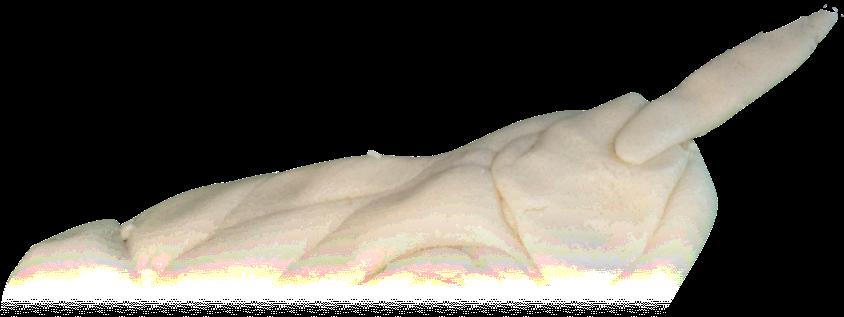

“This is my invariable advice to people: Learn how to cook- try new recipes, lean from your mistakes, be fearless and above all, have fun.”
Julia Child [Cooking teacher and author]
Salt Dough



Children loved working with the Salt Dough. At first, the dough was very hard and cold, as we took it out of the fridge. To the children’s excitement, with the very first touches, it quickly became sticky and stretchy. One of the groups I worked with seemed to be on the same wavelength.




As soon as the children sat down, they began to experiment with the dough's stretchiness and stickiness. Some made the dough ‘rain’ down as they squeezed it between their fingers, while others held the entire piece up high, watching it slowly droop and plop down. Others still, squished the dough with the palms of their hands and watched how it stretches when they try to ‘unglue’ their









At some point there was a small competition between the children about who can stretch the dough widest without breaking it, using either fingers or hands.

N wanted to test how resilient the dough is when you pull it up with an object. He was excited to find out he had to use a lot of strength to ‘fight’ the dough’s grip to the board, and how eventually he would win and the dough would stretch up high and finally break.

T continued this experiment by wrapping dough around his entire hand. He said he really liked the coldness and the jellylike sensation when he pats his dough covered hand.
We notice that, through his senses he is connecting to the conditions of the dough in temperature and texture. He experimented with moving his fingers inside the dough and then ‘rescuing’ his hand out of the dough’s grip.
Another group of children weren’t sure what to do with the cold dough at first. Instead of touching it, they turned it upside down and squished it between their work boards and the table. This exploration led to an exciting discovery of making imprints on the dough’s surface. The table cover left many little square imprints on the dough. The children started feeling the design with their palms. And this stimulated further inquiry into imprints: of hands, fingers and later, rollers. As J used the boards, he explains,



“You squish it and it turns into squares. It feels bumpy. I want to make some more…”

The next group noticed that if you slap the dough, it makes an interesting jelly-like sound. One of the boys began theorizing about the reason for this sound. He experimented with slapping his work board and the table and comparing all three sounds. This conversation led into a drumming session by some of the children. B wanted to make a food bowl in the same way she did using clay previously. Yet the dough would just flop down and the sides wouldn’t stay up as she wanted. She shared her wondering about why this is happening, and then decided to make a flat plate instead.

Once children were introduced to a variety of tools, they experimented with cutting and scraping the dough, as well as making patterns and designs using cutters, rollers and sticks.






Children noticed that salt dough was very different to clay and Nendo. The objects and design they were able to make with it had to be more flat. They particularly enjoyed the sensory experience it offered and were looking forward to baking
 I like it. Feels like snake cold. - R
I like it. Feels like snake cold. - R
Chapter 3: Water

“The supreme goodness is like water. It benefits all things without contention. In dwelling, it stays grounded. In being, it flows to depths. In expression, it is honest. In confrontation, it stays gentle. In governance it does not control. In action, it aligns to timing.
It is content with its nature, and therefore cannot be faulted.”
Tao Te Ching [passage 8] by Lao Tzu, Taoist Philosopher
Connecting with Water
A enjoyed touching water on a piece of paper. “I can draw with water.”
Yoko K- Is there any change that you can see about water?
A: Look! Water became cute!
Then, A started drawing a line using water. For a while, I.xx was watching what she was doing.
YK- If you do that, can you draw something?

I started dropping and drawing a line with water. Since water spread out, it became a big circle. Ian exclaims, “Wow, water became a circle.”
YK- Wow, you can make a circle with water. Water can do so many things. Then, he was trying to put a piece of paper on it and said, “Water circle just came out.”


He was also trying to put papers and remove them again and again and again.
I- “It is soooo fun!”
I am left wondering if he could draw or make some creations with his idea of putting papers on water and also putting and removing papers.

I- “Wow, it has changed”
T took a drop and tried to draw with it.
YK- What is going to happen if you do so?


T- “The water changed the paper a lot. Funny!”
She enjoyed drawing with water.



It was very interesting and fun to watch A, I and T inspiring each other and sharing ideas without knowing it.
T- “Water is flowing…”
I think she could draw more by using dropping and water.
T tried to put some water on the oven sheet and checked
Animals in Water
M enjoyed dropping some water on a piece of paper. Then, he was more interested in using color water and again started dropping to draw something.


M explained, “This is my dolphin, look!” He enjoyed using colored water rather than plain water so he could enjoy choosing which paper matched with color water.


Water has Rhythm
L started to make dots in a rhythmic way like… tap tap tap. Yoko W, “What are you making?”
She replied, “A lots of dots and so many green so many green.” In the meantime, she found a bubble in her dot which made her surprised and happy. Since I caught a glimpse of her personality, I kept having a conversation with her. What is green for you?
L- Frogs! Because water is here now.
YW- Where do they live? Do they live in water?
L- Yes, they live in water. But they are on leaves and trees too. They like water.
YW- Do they swim?
L- Maybe???? I know that they like water.
YW- Do you like frogs?
L- No, No, No. Because I can’t touch them. They jump too. But I can draw frogs. She tried to make different sizes and shapes of bubbles.
One of children I happened to see was a very curious child. He watched the boy next to him happily drawing something with water and imitated him. Eventually, he had found his own way of enjoying himself and immersed himself in the world of water. Whatever the reason, we can always find our own new world and enjoy it. And the moment he found a fun world with water, a familiar material that he sees and touches every day, he showed me the best smile.
Yoko Kamikokuryo

I believe all children have a God-given sense of wonder. It was awesome to see children finding their own way place of belonging and exploring.
By observing, water is just not water for the children. For example, I could see various types of her. She was an artist, a conductor and a storyteller as well. I felt as if I was in another world and it was very comfortable for me to stay with her. Water allows children to express their feeling emotions, creativity and fine motor skill, too. In the meantime, they can be scientists as well.
Yoko Watanabe


Chapter 4: Fabric
“Fashion is not something that exists in dresses only. Fashion is in the sky, in the street, fashion has to do with ideas, the way we live, what is happening”
Coco Channel [Fashion Designer]

“Ninja mask”
“I made futon for Yoji” -Y

Playing with Fabric
Marimo- We are going to play with this material today. Do you know what these are called? The children responded with diverse guesses: paper, carpet, kimono, clothes, shirt..





Then I introduced the material; f,f,f, fa… N- Fabric!


Marimo- Yes, they are called fabric. Do you find any fabric in this room?
M: I think this (points her clothes) like mine. I agreed with the children in how fabric is a material that we use to keep ourselves warm and covered, like clothes. And also how towels and curtains are made fabric. Children began to touch the different kinds of fabric and feel the texture. One of the children noticed the fluffy quality and another the condition of shiny and see-through. Then, K exclaimed, “I want to cut!”. After she tried using scissors, she realized the materials was quite difficult to cut. K, “It’s hard.”
“I can see you!”
Marimo- Why do you think it's so hard?
K- I don’t know…
M- I want to use scissors, too. I want to make something to put on my shirt. It was hard to cut the fabric with paper scissors.
M was so careful and patient to cut the fabric.
K- Can I just rip it? Wow I did it!
Marimo- Was it easy?
K- Yes. Can I try this one?
K and his friend tried to pull the fabric together.
K- Please pull it! More more!
The fabric was strong and did not rip. I asked, Why do you think this fabric didn’t rip?
K- I don’t know. This is a strong fabric! It was a good experiment that the scissors in the classroom were not for the fabric and it was so hard to cut the fabric.



M- I want to use scissors, too. I want to make something to put on my shirt.
It was hard to cut the fabric with paper scissors. M was so careful and patient to cut the fabric.

K- Can I just rip it? Wow I did it!
Marimo: Was it easy?
K- Yes. Can I try this one?
Marimo- Yes

K and his friend tried to pull the fabric together.
K- Please pull it! More more!
The fabric was strong and did not rip. It was a good experiment that the scissors in the classroom were not for the fabric and it was so hard to cut the fabric.
Other children used the fabric in ways in which they could design something to wear. T made his fabric into a belt, and he was very proud. I asked, why did you choose this fabric?




T- Because it is a kimono.
M. Made a scarf and later she made a dress to go to the party. For some children, fabric is a material for clothes, they try to put them on their bodies, while for others, it could be anything, like food.

A- I made curry!!
V- I made something I can put on a boat!
A I rolled the fabric.
T- Was it easy to roll the fabric?
A- Yes
T- Was it easier to roll the fabric than paper?
A- Yes.
T- Can you hold it upright? (He tried, but it didn’t stand up)
Marimo: Why do you think it didn’t?


A- ummm, I don’t know… maybe too

R- I made a tuna roll!
T- It is a huge tuna roll!
R- Because I love tuna rolls. For some children, they see fabric like they see paper, as a material to make things.

K- I’m a Halloween monster!!
C- Wow! Big fabric!
C- Everybody, come in!
C- It’s like a tent!
M- N, come here!
N got inside the fabric and Masatsugu rolled him up.
Marimo: What is the name of the play?

N- I don’t know what it is called, but it is fun!
M- Guru guru (rolling it up)
For some children, the fabric is a versatile toy to play with.

The word, “fabric” was not a very familiar word for children and was even hard for me to describe to the children. We have some dresses and clothes to play with, but don’t have just “fabric” to play with in the ELC. We adults think we may need specific tools to manipulate the fabric, like scissors and needles, but the children used prior knowledge and their imaginations and they were less rigid with their methods. The children seemed to fall into three groups. One group wore fabric as clothes and props, while another group preferred using larger pieces of fabric as toys. The last group of children manipulated the fabric using the tools and made things. This activity brought out each child’s natural tendency; some were more focused on imagination and play while others focused on making something.
Marimo Yagi


Chapter 5: Tie-Dye

“In the beginning it looks a little simpler, and once it’s all connected it becomes something much more different... similar to you, all alone, you are one thing, but when you become a group, you become something very different, very beautiful.”
 Richard Carbin [Local Tie-Dye Artist]
Richard Carbin [Local Tie-Dye Artist]
Discovering Tie-dye
I asked the children if they knew what we would be doing as they observed the colors in the jars with the droppers. The children in chorus replies,




“Making a rainbow!!”
The children are excited to see all the color ink in jars on the table. I explained to the children that we would be doing tie-dye. I explained that we would be using paper, so we do not tie, but fold the paper. There are many different ways to fold paper, and today we are going to fold paper in a triangle. One of the children asked, “why triangle, why do we fold paper first?”
I showed how to fold paper in a triangle. And how to use droppers to put colors to it. Then, I showed that we need to unfold the paper after you finish putting color. Everyone's eyes were on the paper.



K- “Wow! Beautiful! I want to make it too!”
The children were enthusiastic about applying colors. The table became quiet for a moment. The only conversation I heard were:


Where is blue?
Can you pass me a red jar?
We need more yellow!
As they put colors, I heard: Red and blue makes purple. Red and yellow makes orange.
Dots, dots..
Dots, dots, I like dots. Do I need to cover the paper with colors? Maybe I can blow it.
When they unfold the paper, one child noticed, “It’s wet!” And another one saw the challenges, “It is not easy to unfold the wet paper.”

They were all very careful of unfolding the paper, not to rip it. I asked the children their thoughts about the product they were seeing,

E- It is like the sun.




M- It is like a butterfly.
K- It is like a dinosaur.
For some children, the reactions were subtle with many “Hmmm”

But those children immediately said to me, “Can I do it again?!”
“One more time!”
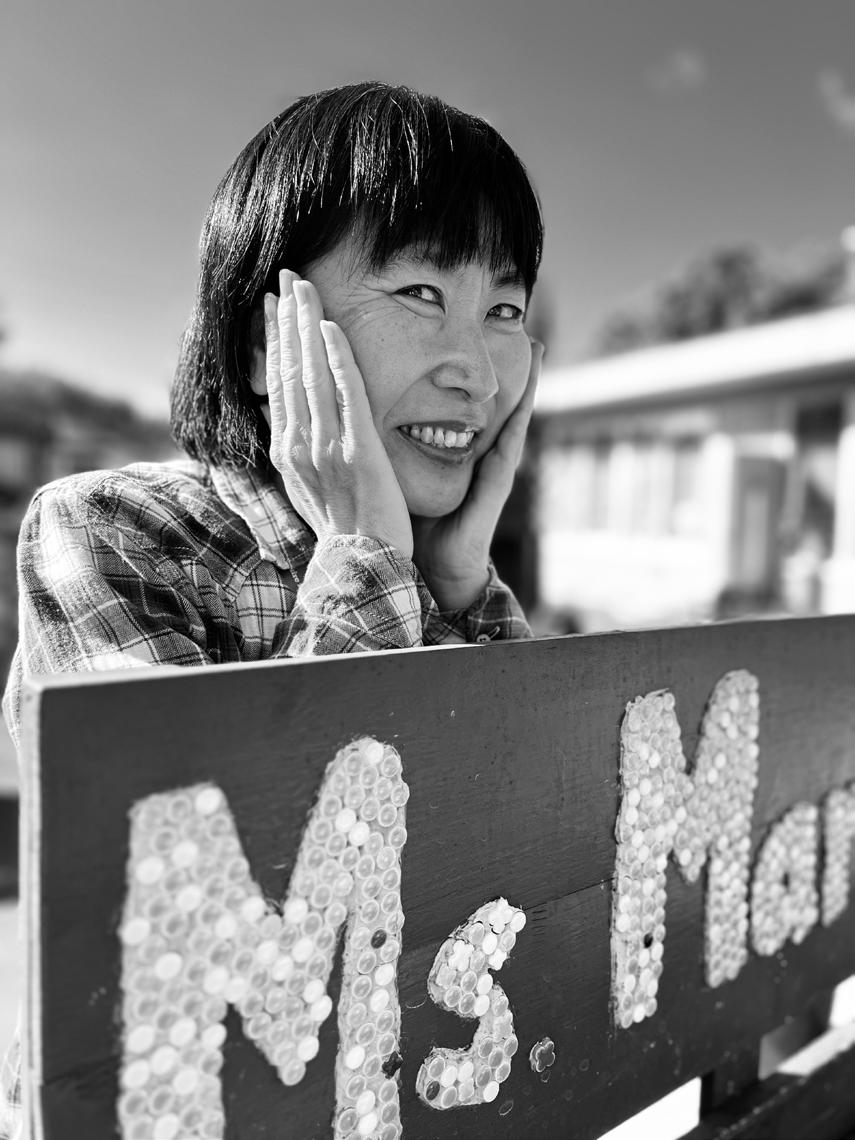
R- “Can I try without folding the paper? I want to put on lots of colors!”
Bold and yet delicate, the simple expressions of children are often tinged with genius. In the process of making tie-dye, the physical act of creation and the infinite realm of imagination are integrated. Even when we aim for something, the result is often different from what we expect. Along with the fun and joy , it often brings new discoveries. Tiedye activates the imagination. Even we, as the viewers, start to wonder, ”what were they thinking and feeling when they made this?” The inspiration seems to radiate outwards from there.


 Marimo Yagi
Marimo Yagi


Chapter 6: Strings



“You cannot go through life without connecting with other people. It is not possible; we need connection. But I believe art helps you return to yourself”
 Chiharu Shiota [Contemporary String Artist]
Chiharu Shiota [Contemporary String Artist]
The Challenge of Strings




K showed great determination, curiosity and attention to this material. He seemed to be engaged with it and I just wondered why he thought of a burger for his string art exploration. He chose the paper with holes and started to sowed the strings to it. He seemed to be having a difficult time doing this, but he was so eagerly trying to put the strings in, and his patience on this journey was commendable. He was not successful in putting the string in the holes of the paper, so he revised his plan. Instead of putting the strings on the hole, he stacked them on the paper.

I asked him, “What are you trying to make?” And he replied, “This is a burger!” He put the paper he cut on top of it and said, “Here is the burger! This burger is so yummy!” He pretended to eat and finish the burger.

Fashion Through Strings




I thought that S was not particularly interested in this material and did not really want to explore more into it but, what surprised me was the fact that the simple thing he created made him feel so proud, I could sense the joy he had on creating it on his own and that made this moment truly special to witness.
He pointed to the necklace he made and pointed to my phone. I figured he wanted me to take a picture of it and so I did. I noticed that he used a tape to connect the ends of the string.


He made sure that the “necklace” was strong and would not easily break so he tested it through pulling the string in different directions.
He was so happy that his creation was strong and did not break. He brought his necklace the next day and the rest of the week, S wore his necklace with pride in school.

From One Kind of String to Two Artworks

I was wondering why Y chose to work on a single kind of string. She immediately and the color yellow and made two creations out of it. She laid down the string on a black paper and started to tape it to make it stay in place. “This is a house, Look this is the door”, she explained. I thought she was already done creating something, but then she turned the paper where she made the house and started to create a new one. I observed quietly as she started to draw on the paper. I then asked her what she was making she replied, is a princess, she is going to the house. She said hello”


When we used strings as our primary material, I observed that the kids had trouble using it. Most children learned new skills as a result of this challenge, including how to tie strings, use hole punchers properly, and learn how to utilize tape. After a week of exploring string, I discovered how excellent a material it is for honing fine-motor abilities. would continue to use strings at the Atelier, sharing my knowledge with the children as we figured out new, imaginative ways to use it to express ourselves.
Liwa Gabriel





Chapter 7: Cardboard
“Inside a big cardboard box, a child is transported to a world of his or her own, one where anything is possible.”
Anonymous

Versatile Cardboard

M’s exploration started with this statements:


“Look Ms. Liwa, it can be a ….chair, bracelet, mask, headband…”
“Look, it looks like a bee house”. As we started the exploration of cardboard, she walked around to try out the different boxes available, in search of which ones would be strong enough to be her chair. None seemed strong enough. So she decided to just hold on to it and pretended to sit on it. Through this journey, we noticed M discovering the qualities that cardboard can afford. She then saw a friend peeling the outer part of the cardboard and she did the same. She thought it looked like a bee house.

She cut a piece of the cardboard, and put it on her wrist. She said, “it is a bracelet"

The Function



While children started exploring the affordance of cardboard, T found an inquiry in the relationship between sound and this hard material. He started to stroke the cardboard using his nails creating sounds. He created music using cardboard, pretending it was a drum. I asked him, “Are you having a concert?.”



“Yes! listen Ms. Liwa” He then made “money” using cardboard. He said I needed to pay him using this money so he will play music. I asked him to tell me the and he was able to name them
E finds independence and creativity in her relationship with cardboard. Her journey started with scissors as she noticed that the thick cardboard was hard to cut. As a solution to this challenge, she chose to work on the thinner boxes. She cut the thin cardboard into small pieces. I asked her what it was, and she replied, “Yuki!” (snow)
Finding stories of kindness
E finds kindness in her relationship with cardboard. E’s thoughtfulness was reflected throughout the process of making her cardboard train. We noticed how this material amplified her creative way of thinking on how she could use given materials to make her ideas into reality.



E noticed that today we got bigger boxes, she immediately lined them and started taping them together. Friends saw what she was doing and they started working together, helping her to tape the boxes. E did not mind, she said, “This train is for all of us”. She told her friends, “Go and sit, I will put on a seatbelt.”
I asked her why they needed to put on a seatbelt, she replied, “So



everyone is safe during the ride”
Finding Fantasy
M found a Silly Monster as he explored the qualities of cardboard. During this process, He was able to think creatively with the cardboard as he designed a monster with all the body parts and he also was able to independently write words on his project. He started to cut the cardboard boxes, I asked him what he was planning on doing but he said he would tell me later. He then went on to cut other pieces of cardboard.

I gathered cardboard of all types and sizes and provided it to the children as is. "Think and show how you might use this material," I asked. I honestly thought they would just stack the boxes or smash everything, which is already fantastic, but much to my surprise, they put it to use in unexpected ways. I'm impressed by how the children investigated how different boxes produce sounds when people scratch, tap, or smash them together.
 Liwa Gabriel
Liwa Gabriel





Chapter 8: Wood
“The great danger for most of us lies not in setting our aim too high and falling short; but in setting our aim too low, and achieving our mark.”
 Michelangelo [High Renaissance Artist]
Michelangelo [High Renaissance Artist]
Time Meets Wood (almost…)


A had a clear idea to make a clock with wood. But at the beginning, she was afraid of using a hammer because it was heavy and first time using it. She could convey her feelings to the teacher. She tried to take a wait-and-see attitude around her for a while. She said to me,


“If Ms.Yoko help me to hold my nails, I want to make a clock. Please help me.” I could feel her passion. She listened to explanations carefully and followed them step by step. What I was inspired by her, was that safety felt like her priority to consider when running the production process and she looked at herself with an objective eye. She tried to make a rhythmic sound like “Ton ton ton” in Japanese, she concluded, “I need to put two sticks for my clock.” After she hammered a nail into a wood she was ready to write down numbers, however she realized that she didn’t know how to write the numbers from 1-12. She said “I can write 1,2, 3… not big numbers.” didn’t like to copy the numbers which Ms.Yoko wrote down. After being at a loss, she explained, “I can make a face with a hat. Because I can draw a face. I like to use a soft material for my hat, not wood.” She seemed to enjoy drawing a face and liked her hat very much. She made explorations into her material and ideas, and was very flexible. She was also able to clarify what specific materials she needed when she used the word soft, knowing now, that wood is hard, not soft.

Difficulties with Wood

As the children started to explore wood. K stated, “I want to make a Rube Goldberg machine”. This could be complicated… There is a Japanese educational TV program that has been loved for over 20 years. It's called a Pyhtagora Switch, which in English is called a Rube Goldberg machine. Making the machine is a child’s dreams since I heard from many children that they wanted to make it. The moment K picked up the wood pieces, he remembered the program and wanted to make his own machine. He wanted to make a machine by arranging wood of various shapes, but it seemed that another idea came to his mind.


“I want to put this on this piece because this will be an airplane… I want this wing not to move” In his mind, he had a fixed image of the completed airplane so he carefully put it together using a hammer and nails. He looked so happy to make his ideal airplane with wood pieces. I wondered if he could try the machine he wanted to make at first because he already had an idea and a plan he could try.


Navigating uncomfortable conditions in wood




M didn't enjoy shaving sand down the surface, she stopped shaving in very short time. Ms.Yoko asked “why?” And M explained, "I don't like the sound and texture. My clothes get dirty with many powders.” And then She had a clear idea to make a car with wood. I asked her “Why do you want to make a car with wood?” She replied, “My family likes traveling and I ride a car every day.” At the beginning, the teachers gave a demonstration on how to hit the nail by holding two fingers and the teachers would help them to hold the nails, especially in the first hit. However, she refused the teacher’s helps. I was curious how she would drive a first nail with a hammer. She started to nail the straw to a wood and spit marked where she should start and screwed in a nail to the chopsticks. She said to me with a smile on her face, “See, I could do it!” She was very proud of her success and filled with satisfaction. she enjoyed exploring this material and the hammer as a tool.

I was impressed by her determination and deep thinking. I leaned about the spirit of challenge from children’s experience.
L wanted to make a helicopter. She had a picture in her mind and tried really hard to piece things together the way she imagined. L expressed frustration at the challenges this presented. Yet she refused to give up and persevered for two days until the wood design began to look like what she intended for it to be. Communicating her ideas in a dialogue with the teacher during the making process helped L to problem solve and find solutions to her question, “How can I make this stay like a triangle? The bottom HAS to be a triangle! And then the top part has to be way up here.” She made a beautiful helicopter as a result and had a very unique perspective on how it should look like. Through this experience of exploring woodworking with the children, I realized what a low-risk activity it was.



Frustrations that lead to creations
 Lyla navigates the tensions of being frustrated as she understands what wood can afford for her creation.
Lyla navigates the tensions of being frustrated as she understands what wood can afford for her creation.
Reflections with Wood


There was something really special about woodworking. It seemed so different from other activities. Children demonstrated a certain feeling of comfort around wood. It is possibly a result of wood being such a big part of our daily lives, such as outside on the playground and inside with loose parts play and block construction. Children were not very keen on exploring just wood as a separate material. As soon as they entered the woodworking area, their eyes immediately started to search out the woodworking tools introduced to them, and the possibilities that these will bring. “Is that a HAMMER?” chimed in a very excited and surprised voice. Some children used wood pieces as familiar loose parts and began making shapes and words on the floor. Others expressed curiosity about the long flexible strips of wood and what kind of opportunities those provided. One of the children commented, “This is thin like paper.” Another child reflected, “I can bend it. Look, it’s a rainbow! And now it’s a circle!” Some children used sandpaper to experiment with the wood textures it creates.



Once it was time to explore other woodworking tools, such as nails and hammers, the room went abuzz! There were endless possibilities and ideas flying through the air. Children were captivated to be trusted with real tools. They were busy working to express themselves and solve problems through this familiar yet unfamiliar way. I noticed how determined children were to make their imagination come to life. Sometimes, the youngest children had to use two hands to hold the hammer up and master the strength enough to hit the nail. It was a unique experience to discover how safely and seriously children handled the tools. Once I demonstrated how to carefully hold the nail to make the initial drive of the nail into the wood, they took on the challenge with confidence and eagerness to learn. R was very attentive. He was able to immediately transfer these intricacies into his own handling of the hammer: from the initial positioning with gentleness of the nail, he manipulated the force of the hammer in relation to its thin structure. In the process, he was aware to protect his fingers and easily drove the nail all the way into the wood.






“It’s a flying car, it’s an airplane going to Tokyo”
Children eagerly accepted the basic safety measures and displayed a safety conscious behavior all throughout their work with this material. I feel it’s very important that young children get to experience risk within a controlled environment and learn how to make knowledgeable calculated decisions about their own and others Woodworking offered extremely high levels of engagement in every child, really deep focus, calmness, perseverance and problem solving opportunities. Children used a lot of imagination to express themselves through creative design. Even the youngest of the group demonstrated a “can-do” attitude and I didn't hear anyone saying: “It’s too hard! I can’t do it!” There was a lot of confidence and appreciation for the opportunities

Thanks to Ms. Zana’s idea of using wood and a hammer together. think children had a new and fun experience with this inquiry. The moment I could see the children trying things they had never done before was the most interesting and precious time. have felt a great sense of accomplishment, despite the short time. I also learned from observing children’s experience, that wood material can stick to anything with a hammer and nails, so I'm sure they will continue exploring ideas to make other creations.
 -Yoko Kamikokuryo
-Yoko Kamikokuryo



Chapter 9: Loose Parts


“T"The wider the range of possibilities we offer children, the more intense will be their motivations and the richer their experiences."
Loris Malaguzzi [Early childhood educator]
Discovering Versatility


Children explored this material made of different and versatile components. R was very comfortable using loose parts. He began building right away. When I asked him to tell me about what he made he said, “It is…a something.” He liked using a lot of different materials from the loose parts. The second time R came he chose to work together with a few other children. Together with two other children, R began creating a scene.

In the first round K was hesitant to creating anything. He watched the other children work intently but never picked up any materials of his own. The second time he visited Loose parts he had an idea in his mind. With more materials to use he still chose just one material to create with. He used the small circle tiles to make a dinosaur. When he finished I asked him what else he could add to his creation. He did not know. I asked, “What is the dinosaur doing? Is he in the forest? Is he eating? Is he sleeping?” he said he was eating and continued to create a dish with food in it next


E was very comfortable with this medium and began to create right away. She built, flowers, people and abstract creations.The second time she visited she created two faces split by straw. She said they were sisters. E took her time when creating. When she finishes a creation, she often does not add to it, but rather creates something new.
L began by using just a few materials. She called me over, “I am done.” I told her she could add more to it or start something new. She continued to add to her creation. She called me over two more times to show how her art had changed. She did not overwhelm what she was making. The second time L visited me, she was ready to begin right away. She eagerly grabbed materials she wanted to use.










K created a happy face. After he spent a good amount of time working on fastening a pipe cleaner around one of the wooden rings. This took a lot of dexterity and he concentrated on it.





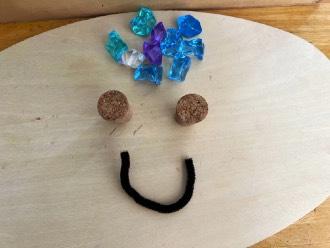



In the first part of this experience, Ian was interested in the materials and excited to build. He made a caterpillar and a sun. The second time Ian came I had shown the children some visuals that some of the other ELC children had made. Ian chose to make a flower. When I asked him about it he said, Pointing to the screen at the front of the room.

T spent the whole work time making these flowers with black stones and pink tiles. She was very careful about putting the pink tiles and black stones down so they would sit exactly where she wanted them. Some overlapped and she had to balance them on other stones. Her second visit she used the entire time creating the flower. She said,

“Like butterfly flower, in the sun, the princess is taking care of the flower.”




L loved working with the blue plastic pieces. He built an ocean with the corks as fish. He was really excited. He started by standing the corks up but then began adding more and more blue pieces and corks. The second time he chose to work on the large mirror. When I asked him about what he was making he did not have an answer. However, when he finished “Scary Monster.” again really liked the plastic pieces and used mostly those. Then he discovered the paper straws. He wanted to hand out straws to everyone. The other children did not want the straws so I encouraged him, “you can use them if you want.” His eyes lit up and he went back to his space to add them to his creation. That is how he got the scary monster.



When I was explaining Loose parts I demonstrated that I could use the pieces to make something, like a flower. S loved that idea and said, “I am gonna make a flower!” She ended up creating three flowers. She added a lot more details to her flowers than I had in the demonstration. She said her flowers were beautiful. The second time S came, she worked with different materials using stones and coral. She described her creation saying, “The girl is in parade. She is playing the horn and banging the cymbals and this is the rainbow.” She described each part by pointing and saying “the horn, and the eyes, and the wings and the smiley face.”

The first time A came to Loose parts she watched a lot of the bigger kids around her to see what to do. She slowly got started using lots of different materials but was unable to explain to me what she had



The second time A was more ready to begin working. She didn’t look around but just said this is “Momma’s car. A inside.” She enjoyed experimenting with paper straws by bending them.




Initially, M used only wood pieces. Then he added some subtle color. It was interesting to see him working with only one type of part for a long time before choosing to add color. The second visit he chose to work on the picture frame. He used less materials but was careful about which pieces he chose. He titled his work, “Mr. Nothing Monster.”




M had clearly worked with Loose parts before. She got right to work and made a face. She said, “Ms. Puffer look face!” She giggled. The second time she was fascinated by the mirrors. She chose to work on a small square mirror, but rather than building anything with loose parts, she took two of the smaller mirrors and faced them toward the bigger square mirror. She spent her time working with light and the mirrors reflecting on each other.




T enjoyed working with loose parts and it was quickly apparent this was not his first time. He began working quickly with the materials he had. Each time he would call out,“Ms. Puffer finish!” I would go to see what he made. Then he enjoyed putting everything back and starting anew. The second time he used the large mirror. He was very excited to work with the plastic caps. He collected the materials he needed and went over to put them on the mirror. He rearranged the caps a few times creating new designs with them.

The first visit K switched between organizing the materials in a pattern on his tray and gathering materials in a pile. Each time he finished a creation I gave him the choice to add to it or start new. He always chose to start a new creation. The second time he was more focused in his designs creating faces with
different materials. He began with caps and later switched to glass beads. He did not want to talk about his creations but enjoyed moving all the pieces around.




could look like as she moved and changed the materials in front of her.



Initially, E observed what the children around her were making. She watched carefully as they selected materials and arranged them on their boards. Then, began by choosing small colored discs. She spaced them out on the board. Adding other materials exploring what her creation



S began slowly by adding just a few materials. He spaced them out on his board. Each time he went back to the material area he found more and more materials he wanted to use. He really enjoyed adding different kinds of materials on top of one another. At the end of our time together he had almost one of every material in his creation.

J liked to use the black stones and began creating. He and N worked together at first, then chose to make separate pictures. J loves making ocean drawings so he carried that here. The second time J came to loose parts he was so happy to use the blue gems to make the ocean. He added some coral and some glass beads that he said were fish. J said the brown wooden disks were the sand. He added the sun. By the time we finished our group, he had a sea snake and two gas tanks that he said are outside the ocean.







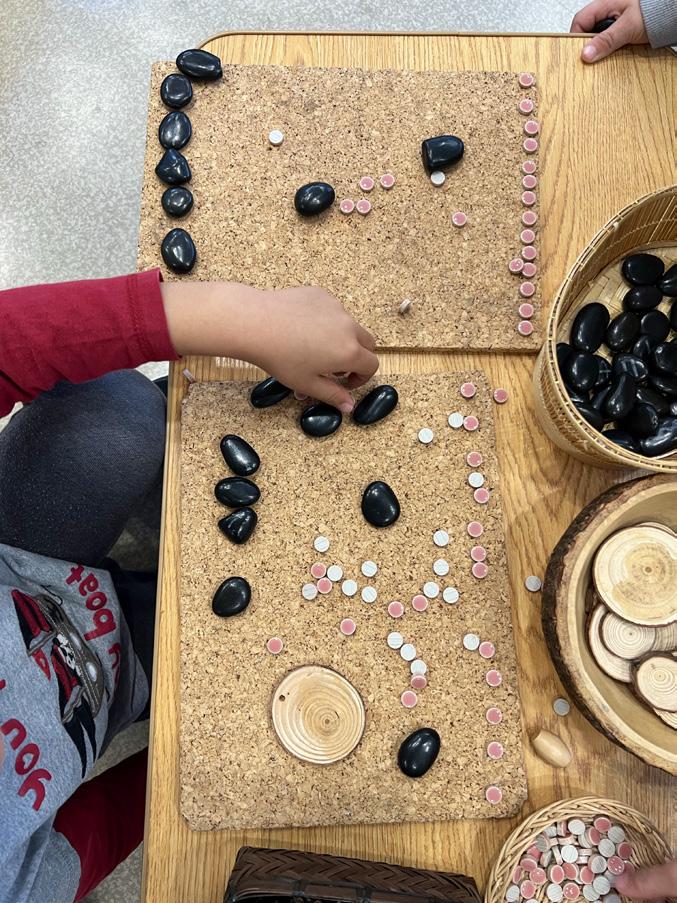
N was not sure what to make at first so he began by building together with J. Once they got going though, N created a rocket blasting off into space. He lined small tiles along the top to show where space is. Later he added some pieces flying off the rocket as it flew into space. The second time N came to loose parts he chose to work on a slab of wood. He was excited to work with different (more than the first time). He began by using wooden disks. He piled the different sized disks on top of one another to make a volcano shape. He decided to create a piece of his picture that stood up. He piled wooden disks on cork so it stood like a tower.

This was not Y first time using loose parts. She was happy to have the blue gems to use. She created a face with wooden circles and blue


The second time she visited, she chose to work on a square mirror. She created a simple picture with glass beads and shells. When I came back to check, she had added so much more detail to her



R also got to work right away. He gathered a variety of materials to make his design. This evolved and changed each time I looked at it. He would switch certain materials or change the shape of the design. The second visit R chose to work on a large frame. In the introduction to the lesson I had shown an example of how another ELC child had tried to stack materials on top of one another. He was inspired and began to collect wooden disks and corks. He stacked them up and they fell down. He stacked them up over and over trying to make his stack taller. Each time it fell down he would change how he stacked them. Eventually he changed the kind of cork he was using and was more successful. R was working carefully and slowly to make his stack. He was even able to put a couple plastic caps in the stack. He was very proud of his work.

The first round S enjoyed stacking materials on top of one another. He used mostly wooden disks and stones. The second time he chose to work on a large piece of black paper continuing to stack. This time he worked with a variety of materials. I asked, “How could you use the rest of this space on the paper? Are there other materials or details you could add?” He thought for a minute and went back to work. When I returned he had rearranged his entire stack of materials to the opposite corner of the page. That blank space was a part of the creation he clearly wanted to keep.
One of the amazing things I love about Loose Parts is the endless possibilities it holds for children. When creating with Loose Parts children can be literal or imaginative. They can create small things or big things, they can use many materials or one material. The possibilities are endless. I think the thing that surprised me the most was how much they inspired each other. Children began to create, then they would look around at what the other children were making, how they were using certain materials, which materials they were using and soon their own creation was evolving. Some children chose to make multiple creations in one sitting and others just worked carefully on one thing the whole time. Loose Parts is so open-ended, it really lets you see the creativity flowing differently from child to child.
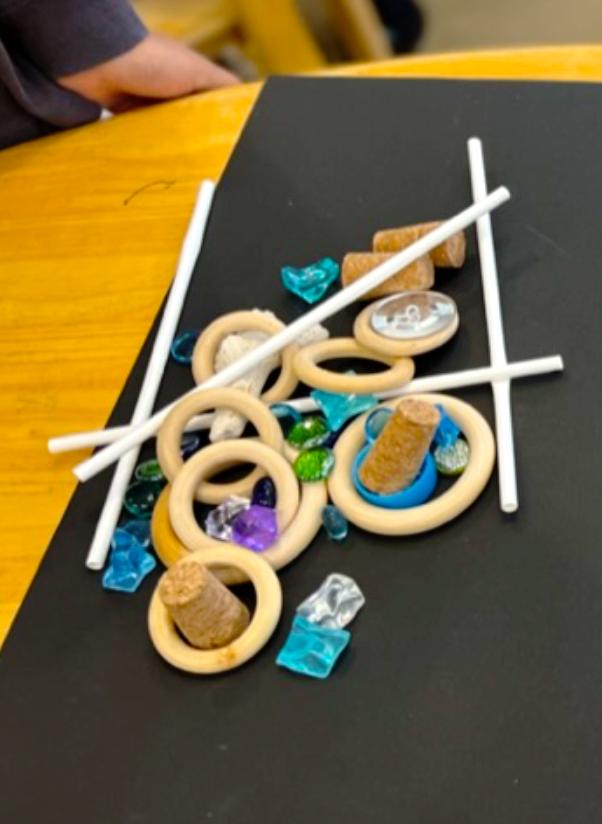
 Ginger Puffer
Ginger Puffer






Chapter 10: Light, Shadow, Color & Sound


“Nothing can dim the light that shines from within”
Maya Angelou [Writer & Activist]
Light & Shadow



Our exploration of light as a material in contrast with darkness, lead into the discovery of shadows, which turned into an intangible material, but one which became the source in understanding form. In the sensory room, children have their first encounters

L discovers the circle created by a wooden loose part which was placed on the overhead projector. Children also discover the light and the mirror on the projector and wonder about the effects, when moving the device in different ways together with the items placed on the surface.

What is light? “It’s dark up in the sky!”





“I like the machine because it has a mirror” -M

“Giraffe shadow and me, it is bigger”

“The shadow in the night is big like a sun, so your shadow is gone when the moon is up.”

-V
-T
-E
Testing and Proving Theories


“I am making light on this hole”, L exclaims as she moves the puppet in front of the circular light .



Ms. Maia- I wonder why you are putting the light through the hole?


“Because then I can make some shadow…”
R comes and stands in front of the shadow she is making.
L- “Oh! Now I can’t see the shadow”
Ms. Maia- Why do you think that happened?
L- “Because if someone stands in front of the light, then you can’t make the shadow”
What might be the relationship between me and my shadow?



“I
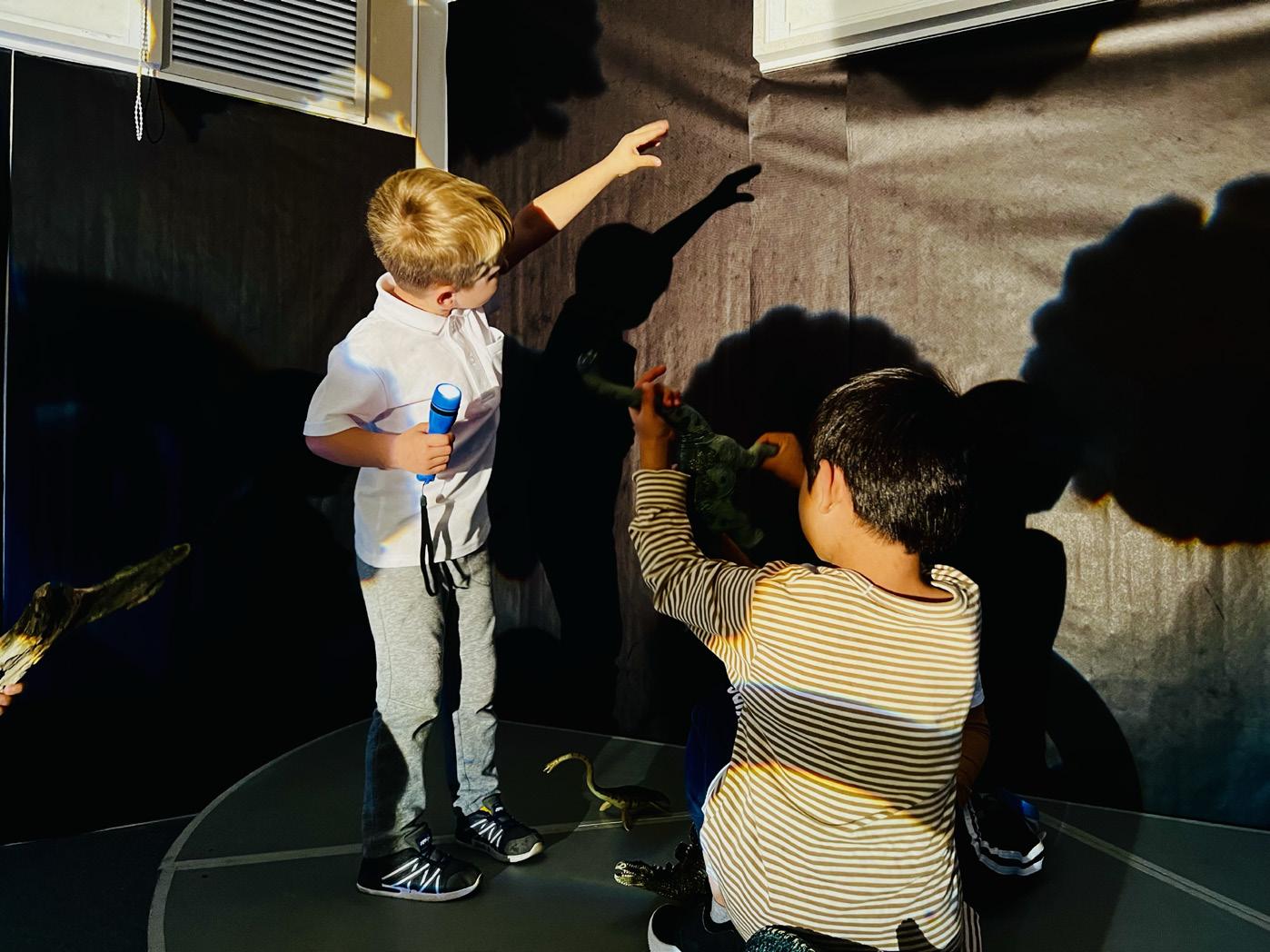
“I am making a crocodile puppet with my hand”
-N
-B
see the light and the shadow of my hand”
Textures a missing sense of touch but one that will build form.
The use of different materials supported the children in building conceptual understanding of how shadow worked around the principle of light, and in contrast with themselves. This supported the conditions for them to test different transfer in sizes and shapes, which helped them tap into the key concept of form and perspective to understand the affordance of light.




-K
“I see hand shadow with light”
M tests her theories and thoughts around her developing understanding of how
The first connection the children made was the moon.


Rainbow!!
In childhood, the first lessons in physics are born from simple interactions with the environment.



Butterflies!!
Children build schema in connection to their environment, their third teacher.




Light, Shadow & Color
The following week, we added the concept of color as an additional material, through which the children will test the conditions of color, and what this could afford with light and shadow.









“I see yellow! -K
“I make red” -L
“Look! All is green” -T
A looks at the reflection of her shadow amongst the colored shapes that K is moving on the overhead camera.

M mixes the colors by overlapping the colored blocks, noticing secondary colors reflected on the light table. And R discovers the reflection of the colors through the use of a flashlight against the dark wall.


The contrast and duality of life: We can see light because of darkness.
K and T find ways to collaborate as they use the same pieces to build similar structures (pyramids).

E finds different ways to build forms within the condition of each colored material.


What might be the relationship between color, light and myself?
Children experiment with the projector camera and discover how the colors transfer onto the wall, becoming part of their bodies.



“The colors made my shirt rainbow like the sky, so beautiful!” -S
How does light make you feel? Warm
While E creates a robot on the light table, K explores the projector camera examining the reflection of the colored water, and then building an airplane with 2dimensional shapes over the mirrorsurfaced.





Light, Shadow, Color & Sound


After exploring the relationship between Light, Shadow and Color, we introduced sound through diverse genres of music, and instruments. The children intuitively tried matching the beats with the movement of the lights and with sounds they heard in the background. As they explored, theories of rhythm formed.



“They making the music of what it sounds… the instruments are making patterns”

-M
As we explored the relationship of light and shadows, I was reminded of how experiential learning is at the heart of how and why humans learn. Children were encountering discoveries and testing theories. Between their conversations and observations they were building ideas together and clarifying misconceptions. I was awe of how the connections they were evolving will soon be tested as they continue to live. When we added color, I was reminded of the duality of life and how through opposites we learn to appreciate both parts, like being able to see light because of darkness. When we added sound, our senses were amplified and the children found different relationships. These occurrences in the environment like color, light, sound and shadow, became more than natural projections… they transformed into materials, tools, to express ideas, feelings and stories. Through experiential learning the children were able to learn and understand that these languages have conditions and affordances that may or may not support their artistic expressions.

Like A, when she wanted to make a butterfly but then she realized that the form of the translucent shapes were not affording the “soft” form she was looking for.


 Maia Bassett
Maia Bassett
The Artists in Preschool 3








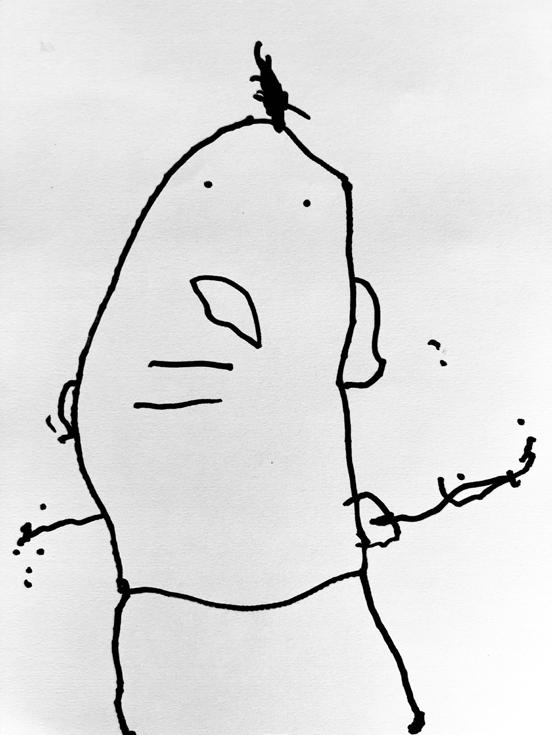
 Valentino 3.11
Kihachiro 3.10
Ren 3.7
Anera 3.7
Kico 3.10
Yoyi 3.5
Valentino 3.11
Kihachiro 3.10
Ren 3.7
Anera 3.7
Kico 3.10
Yoyi 3.5
The Artists in Preschool 4










 Kai 4.10
Noah 4.3
Sara 5.2
Lisa 4.11
Lei 4.4
Kazuki 4.6
Ritsu 5.2
Kai 4.10
Noah 4.3
Sara 5.2
Lisa 4.11
Lei 4.4
Kazuki 4.6
Ritsu 5.2
The Artists in Kindergarten


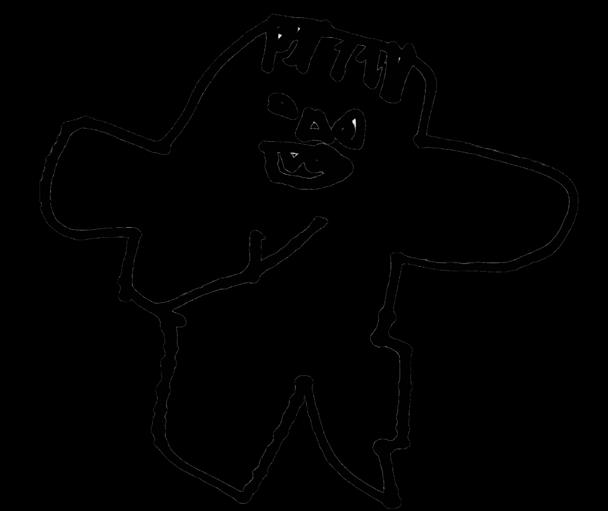


 Lyla 5.7
Eelan 6.0
Blanca 5.8
Rai 6.1
Lyla 5.7
Eelan 6.0
Blanca 5.8
Rai 6.1
The Artists in Kindergarten








Shinya 6.1 Youxia 5.6 Koshiro 5.4 Jun 5.9 Ian 5.7 Misa 5.11 Tsumugi 5.7 Masatsugu 5.8
© Nagoya International School
NIS is an inclusive school community serving the needs of students with various gifts and talents, embracing a diversity of language, culture, and personal identity. Guided by the framework of the International Baccalaureate (IB) Program, our talented educators challenge students to question the answers and stretch their imaginations, empowering them to think creatively and critically, pursue lifelong learning, and contribute positively to the global community.
Educators at the Early Learning Center
Ginger Puffer
Liwa Gabriel
Maia Bassett
Marimo Yagi
Masato Iio
Yoko Kamikokuryo
Yoko Watanabe
2686 Minamihara, Nakashidami Moriyama-ku, Nagoya, Japan 463-002
ingo@nis.ac.jp
www.nis.ac.jp
2686 Minamihara, Nakashidami, Moriyama-ku, Nagoya, 463-0002 Japan info@nis.ac.jp • www.nis.ac.jp























 The Lion that transformed into an elephant by E
The Lion that transformed into an elephant by E







 Snail Butterfly
Mouth
Bunny
Flowers mouth
Snail Butterfly
Mouth
Bunny
Flowers mouth



 Zana Tolkaciova
Zana Tolkaciova
































 I like it. Feels like snake cold. - R
I like it. Feels like snake cold. - R













































 Richard Carbin [Local Tie-Dye Artist]
Richard Carbin [Local Tie-Dye Artist]



















 Marimo Yagi
Marimo Yagi




 Chiharu Shiota [Contemporary String Artist]
Chiharu Shiota [Contemporary String Artist]








































 Liwa Gabriel
Liwa Gabriel





 Michelangelo [High Renaissance Artist]
Michelangelo [High Renaissance Artist]

















 Lyla navigates the tensions of being frustrated as she understands what wood can afford for her creation.
Lyla navigates the tensions of being frustrated as she understands what wood can afford for her creation.









 -Yoko Kamikokuryo
-Yoko Kamikokuryo
















































































 Ginger Puffer
Ginger Puffer












































































 Maia Bassett
Maia Bassett









 Valentino 3.11
Kihachiro 3.10
Ren 3.7
Anera 3.7
Kico 3.10
Yoyi 3.5
Valentino 3.11
Kihachiro 3.10
Ren 3.7
Anera 3.7
Kico 3.10
Yoyi 3.5










 Kai 4.10
Noah 4.3
Sara 5.2
Lisa 4.11
Lei 4.4
Kazuki 4.6
Ritsu 5.2
Kai 4.10
Noah 4.3
Sara 5.2
Lisa 4.11
Lei 4.4
Kazuki 4.6
Ritsu 5.2





 Lyla 5.7
Eelan 6.0
Blanca 5.8
Rai 6.1
Lyla 5.7
Eelan 6.0
Blanca 5.8
Rai 6.1







